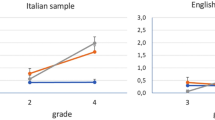Abstract
Growth of word reading skills was examined in first and second year Italian school children by analysis of the pattern of reading errors. The study was designed to investigate the role of visual vs phonological similarities as causes of misreadings in a transparent orthography. The selection of reading material was tailored to permit a meaningful cross-language comparison with pre-existing findings on English-speaking children. The results showed that, in Italian as in English, spatially-related errors (such as confusingb andd) constituted a minor proportion of the total errors. Errors on vowel and consonant letters that are not spatially confusable accounted for the greater proportion of the total. Moreover, the co-occurrence of spatial and phonological confusability resulted in appreciably more errors than when either occurred without the other. Vowel position in the syllable had no systematic effect on errors. In beginning readers of Italian, consonant errors outnumbered vowel errors by a wide margin; the reverse pattern was found in previous studies on English-speaking children at the same level of schooling. It is proposed that differences between Italian and English in the phonological structure of the lexicon and in the consistency of grapheme-phoneme correspondences account in large part for the differences in quantity and distribution of the errors.
Similar content being viewed by others
References
Agard, F. B. & Di Pietro, R. J. (1965).The sounds of English and Italian, Chicago: The University of Chicago Press.
Bryson, S. E. & Werker, J. F. (1989). Toward understanding the problem in severely disabled children, Part I: Vowel errors,Applied Psycholinguistics 10: 1–12.
Byrne, B. (1992). Studies in the acquisition procedure for reading: Rationale, hypotheses, and data. In P. B. Gough, L. C. Ehri & R. Treiman (eds.),Reading acquisition (pp. 1–34). Hillsdale, NJ: Erlbaum.
Carlson, R., Elenius, K., Granstrom, C. & Hunnicut, S. (1985). Phonetic and orthographic properties of the basic vocabulary of five European languages,Quarterly Report (KTH Speech Transmission Laboratory, Stockholm) 1: 63–94.
Chomsky, N., & Halle, M. (1968).The sound pattern of English. New York: Harper and Row.
Cossu, G., Shankweiler, D., Liberman, I. Y., Katz, L. & Tola, G. (1988). Awareness of phonological segments and reading ability in Italian children,Applied Psycholinguistics 9: 1–16.
Ferrero, F. E., Magno-Caldognetto, Vagges, K. & Lavagnoli, C. (1978). Some acoustic characteristics of the Italian vowels,Journal of Italian Linguistics 3: 87–96.
Fischer, F. W., Liberman, I. Y. & Shankweiler, D. P. (1978). Reading reversal and developmental dyslexia: a further study,Cortex 14: 496–510.
Fowler, C., Liberman, I. Y. & Shankweiler, D. (1977). On interpreting the error pattern in beginning reading,Language and Speech 20: 162–173.
Gibson, E. J., Gibson, J. J., Pick, D. & Osser, R. A. (1962). Developmental study of the discrimination of letter-like forms,Journal of Comparative and Physiological Psychology 55: 897–906.
Gleitman, L. R. & Rozin, P. (1977). The structure and acquisition of reading: Relation between orthography and the structure of language. In A. S. Reber & D. L. Scarborough (eds.),Toward a psychology of reading (pp. 1–53). Hillsdale, NJ: Erlbaum.
Gough, P. B. & Hillinger, M. L. (1980). Learning to read: An unnatural act,Bulletin of the Orton Society 30: 179–196.
Hinshelwood, J. (1917).Congenital word blindness. London: H.K. Lewis & Co.
Klima, E. S. (1972). How alphabets might reflect language. In: J. F. Kavanagh and I. Mattingly (eds.),Language by ear and by eye (pp. 57–80). Cambridge: MIT Press.
Liberman, I. Y., Liberman, A. M., Mattingly, I. & Shankweiler, D. (1980). Orthography and the beginning reader. In J. Kavanagh & R. Venezsky (eds.),Orthography, reading and dyslexia (pp. 137–154). Baltimore: University Park Press.
Liberman, I. Y., Shankweiler, D. & Liberman, A. M. (1989). The alphabetic principle and learning to read. In D. Shankweiler & I. Y. Liberman (eds.),Phonology and reading disability: Solving the reading puzzle (pp. 1–33). Ann Arbor, MI: University of Michigan Press.
Liberman, I. Y., Shankweiler, D., Orlando, C., Harris, K. S. & Bell-Berti, F. (1971). Letter confusions and reversals of sequence in the beginning reader: Implication for Orton's theory of Developmental Dyslexia,Cortex 7: 127–142.
Lindgren, S. D., DeRenzi, E. & Richman, L. C. (1985). Cross-national comparisons of developmental dyslexia in Italy and the United States,Child Development 65: 1404–1417.
Mann, V. A., Tobin, P. & Wilson, R. (1987). Measuring phonological awareness through the invented spellings of kindergarten children,Merrill Palmer Quarterly 33: 365–392.
Mayzner, M. S. & Tresselt, M. E. (1965). Tables of single-letter and diagram frequency counts for various word-length and letter-position combinations,Psychonomic Monograph Supplements 1(2): 13–18.
Ognjenovic, V., Lukatela, G., Feldman, L. & Turvey, M. T. (1983). Misreadings by beginning readers of Serbo-Croatian,Quarterly Journal of Experimental Psychology 35: 97–109.
Orton, S. T. (1925). ‘Word blindness’ in school children,Archives of Neurology and Psychiatry 14: 581–615.
Orton, S. T. (1937).Reading, writing and speech problems in children. New York: Norton.
Peterson, G. E. & Barney, H. L. (1952). Control methods used in the study of the vowels,The Journal of the Acoustic Society of America 24: 175–184.
Shankweiler, D. P. & Liberman, I. Y. (1972). Misreading: a search for causes. In J. F. Kavanagh & I. Mattingly (eds.),Reading by ear and by eye (pp. 293–317). Cambridge: MIT Press.
Simner, M. (1982). Printing errors in kindergarten and the prediction of academic performance,Journal of Learning Disabilities 15: 155–159.
Stanovich, K. (1985). Explaining the variance in reading ability in terms of psychological processes: what have we learned?Annals of Dyslexia 35: 67–96.
Vellutino, F. (1987). Dyslexia,Scientific American 256: 34–41.
Venezky, R. (1970).The structure of English orthography. The Hague/Paris: Mouton.
Werker, J.F., Bryson, S. E. & Wassenberg, K. (1989). Toward understanding the problem in severely disabled readers, Part II: Consonant errors,Applied Pscholinguistics 10: 13–30.
Wimmer, H. (1993). Characteristics of developmental dyslexia in a regular writing system,Applied Psycholinguistics 14: 1–33.
Author information
Authors and Affiliations
Rights and permissions
About this article
Cite this article
Cossu, G., Shankweiler, D., Liberman, I.Y. et al. Visual and phonological determinants of misreadings in a transparent orthography. Read Writ 7, 237–256 (1995). https://doi.org/10.1007/BF02539523
Issue Date:
DOI: https://doi.org/10.1007/BF02539523



